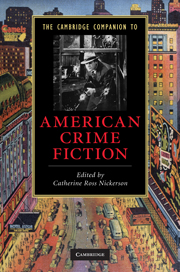Book contents
- Frontmatter
- 1 Introduction: The satisfactions of murder
- 2 Early American crime writing
- 3 Poe and the origins of detective fiction
- 4 Women writers before 1960
- 5 The hard-boiled novel
- 6 The American roman noir
- 7 Teenage detectives and teenage delinquents
- 8 American spy fiction
- 9 The police procedural in literature and on television
- 10 Mafia stories and the American gangster
- 11 True crime
- 12 Race and American crime fiction
- 13 Feminist crime fiction
- 14 Crime in postmodernist fiction
- Guide to reading
- Index
3 - Poe and the origins of detective fiction
Published online by Cambridge University Press: 28 September 2010
- Frontmatter
- 1 Introduction: The satisfactions of murder
- 2 Early American crime writing
- 3 Poe and the origins of detective fiction
- 4 Women writers before 1960
- 5 The hard-boiled novel
- 6 The American roman noir
- 7 Teenage detectives and teenage delinquents
- 8 American spy fiction
- 9 The police procedural in literature and on television
- 10 Mafia stories and the American gangster
- 11 True crime
- 12 Race and American crime fiction
- 13 Feminist crime fiction
- 14 Crime in postmodernist fiction
- Guide to reading
- Index
Summary
“These tales of ratiocination,” Edgar Allan Poe explained to a correspondent in 1846, “owe most of their popularity to being something in a new key.” Poe was referring to his three stories written in the early to mid 1840s featuring C. Auguste Dupin (“The Murders in the Rue Morgue,” “The Mystery of Marie Rogêt” and “The Purloined Letter”). The “new key” was, of course, what we have come to call “detective fiction,” and Poe, as the form's first truly modern exponent, was aware that his stories were enjoying an unprecedented popularity with the reading public. In “The Murders in the Rue Morgue,” Poe introduced readers to the Parisian polymath, Dupin. He was a man for whom ordinary men “wore windows in their bosoms.” Such are Dupin's powers that not only can he seemingly read the narrator's thoughts at the very instant he is thinking them, but he can explain the whole chain of reasoning that had led to his thoughts merely by observing the sequence of expressions on his face. Coming across a case in the newspaper - the grisly killings of Madame L'Espanaye and her daughter in their apparently locked lodgings in the Rue Morgue - Dupin displays his analytical prowess, unraveling the seemingly insoluble mystery.
- Type
- Chapter
- Information
- The Cambridge Companion to American Crime Fiction , pp. 17 - 28Publisher: Cambridge University PressPrint publication year: 2010
- 7
- Cited by

